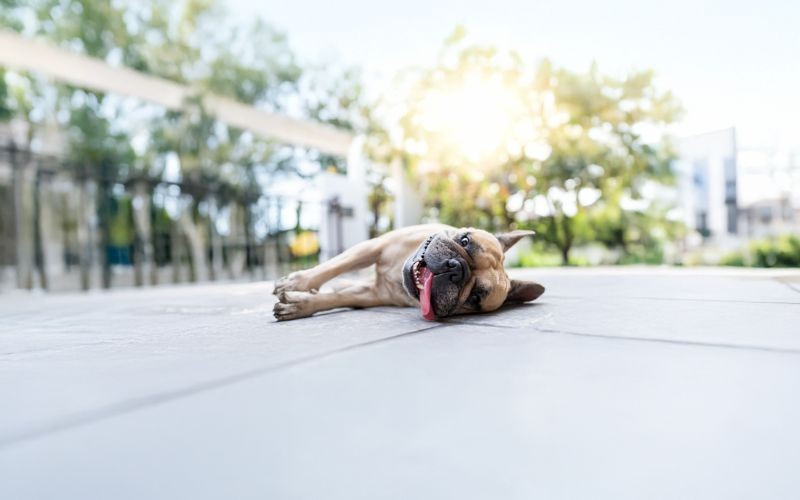
Heatstroke in Pets: What Every Pet Parent Should Know
Summer is all fun and games, only until it gets too hot. While we can reach for a cold drink or find shade, our pets rely entirely on us to protect them from the heat.One of the biggest dangers during warm weather is heatstroke, a serious condition that can affect both dogs and cats quickly and, if not treated, can become life-threatening.
But don’t worry, with the right precautions and a bit of awareness, you can keep your four-legged friend safe and cool all summer long.
What is Heatstroke?
Heatstroke occurs when a pet’s body overheats and can no longer regulate its temperature effectively. Unlike humans, dogs and cats don’t sweat all over, they primarily cool themselves through panting and small amounts of sweat from their paw pads. Some pets are more at risk than others, including:
- Brachycephalic (flat-faced) breeds like Bulldogs, Pugs, and Persian cats
- Puppies, kittens, and senior pets
- Overweight animals
- Pets with thick or dark coats
Early detection can save lives.
Whether it’s a dog or a cat, these are some of the warning signs of heatstroke:
- Rapid or heavy breathing
- Lethargy or weakness
- Staggering or uncoordinated movement
- Excessive drooling (more common in dogs)
- Red or glassy eyes
- Vomiting or diarrhea in severe cases
How to Keep Your Dog Safe When It’s Hot Outside
The good news? Heatstroke can be prevented in most cases, and a few smart habits can make a big difference in your dog’s summer experience.
First rule: avoid going for walks during the hottest hours of the day. Early mornings or late evenings are much better options, not only because the air is cooler, but also because the ground isn’t scorching hot.
A simple way to check if the pavement is too hot? Place the back of your hand on it for a few seconds. If it’s uncomfortable for you, it’s definitely too hot for your dog’s paws.
If you do need to go out during the day, make it quick and stick to shaded areas or grassy paths. To help protect your dog’s paw, you can apply a protective balm before heading out or try lightweight dog boots.
If you’re looking for tips on how to manage walks during hot weather, you’ll find a dedicated article here.
Another common mistake to avoid is letting your dog go for a walk right after a full-body rinse with cold water. While it might seem like a nice way to cool them down, soaking your dog completely can actually backfire. When their coat is soaked, it traps heat instead of letting it escape, basically acting like a warm, wet blanket.
And here’s another important tip, don’t shave your dog in summer. We know, it sounds counterintuitive, but a dog’s coat plays a vital role in regulating their body temperature.
Shaving it off completely removes their natural insulation and exposes their skin to direct sunlight, making it harder for them to stay cool. It can also increase the risk of sunburn and, in predisposed animals, even contribute to the development of skin conditions like melanoma.
How to Keep Your Cat Cool in Hot Weather
Cats may not go for walks like dogs, but they still need help staying cool indoors, especially in hot or poorly ventilated environments.
Keep indoor spaces well-ventilated.
Use fans, keep curtains closed during peak sun hours, and make sure your cat has access to cool, shaded areas.
Offer fresh water in multiple spots.
You can even add an ice cube or use a pet fountain to encourage drinking. Hydration is key to helping cats regulate their body temperature.
Groom regularly.
Brushing helps remove excess fur and prevent mats that can trap heat, especially in long-haired breeds like Maine Coons or Persians.
Important: Avoid shaving your cat unless prescribed by your vet, their coat, like a dog’s, provides essential protection.
Provide cooling surfaces.
Marble tiles, cooling mats, or even a damp towel can give your cat a refreshing place to rest.
Cool Down the Right Way
Soaking your pet completely may seem like a good way to cool them down, but it can backfire, especially in dogs. A wet coat can trap heat instead of helping it escape.
Instead, focus on areas with less fur and better heat exchange:
- Under the belly
- In the armpits
- Inside the thighs
In Short
Heatstroke is serious, but preventable. With a few smart habits and some extra attention, your pet can enjoy summer safely.
For dogs, this means adjusting walks, avoiding unnecessary full body wetting or shaving, and keeping paws protected.
For cats, it’s all about ventilation, hydration, grooming, and creating cool resting areas.

